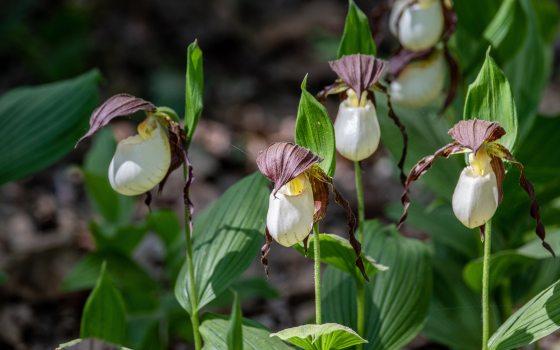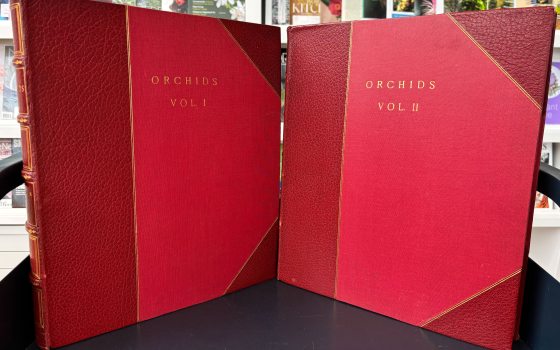This spring we have been feeling the heat in the Meadow Garden! This 86-acre space at Longwood combines horticulture and ecology to create an environmentally sensitive landscape. Although this area of rich biodiversity may seem wild and maintenance free, meadows actually require regular attention. A typical meadow like the one here at Longwood requires regular scouting for invasive plants, the removal of woody plants, and a yearly mowing or burning.
Historically, meadows in the eastern U.S. burned naturally as a result of lightning storms, or by Native Americans, who used fire to maintain plant communities and manage game animal populations. At Longwood, we have been practicing prescribed burns since the mid-1980s, with specific areas being burned on a rotational basis.

Longwood’s prescribed fire team ready to start the carefully planned burn. Photo by Tom Potterfield.
This year a prescribed burn of our Meadow Garden was carried out on April 6. The burned area covered 31 acres spread over predetermined sections called “burn units.” This use of fire is carried out in a controlled manner within appropriate safety “prescriptions” adopted to achieve specific ecological goals for the landscape. It is usually undertaken in the early Spring, and only about 30%–50% of the entire Meadow Garden is burned to ensure that sufficient areas of standing vegetation remain for insect and animal habitat until the Meadow regrows fully, later in the spring.
Our team starts the fire in a carefully selected location so that it will burn into the wind to help reduce the spread and rate of the fire. Then the team starts fires in multiple places around the edges of the burn unit, so that the various fires will eventually meet in the middle and burn themselves out when all the natural fuel is exhausted. Water tanks are used to water down fire break areas both before and during the operation to control the direction and spread of the fire. After the burn is completed, it is always important to ensure smoldering material is properly extinguished to prevent the risk of the fire reigniting.
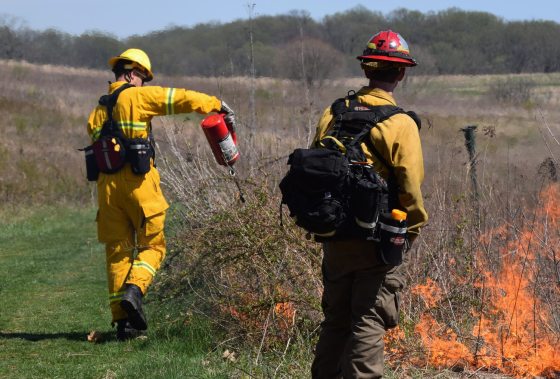
Team members, donned in their protective gear, carefully start the fire in a selected location. Photo by Kirsty Wilson.
Fire helps rejuvenate meadow vegetation and in turn benefits wildlife for a healthier, more diverse, and better functioning ecosystem. The prescribed burn:
- Helps control the encroachment of woody plant species, which would otherwise overtake the Meadow plant community. If the Meadow landscape were left untouched, it would follow a gradual and natural succession to forest, due to the annual rainfall amounts in this part of Pennsylvania that generally support our deciduous Piedmont forest ecosystem.
- Helps control invasive, non-native plant species as these do not have the resistant root systems that many of our native meadow plant species possess.
- Helps remove the buildup of the thatch layer of dead vegetation and improves the release of nutrients from dead plant material so that they can be recycled through the ecosystem. These things, combined with warmer soil (as the fire-blackened soil retains heat better), improve germination of certain native plant species and the renewal of the Meadow.
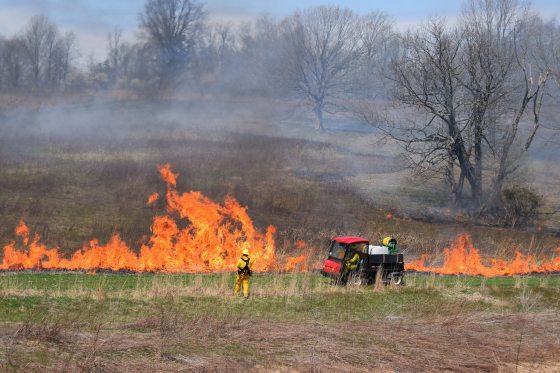
A member of the prescribed burn team monitors the fire, while another member is at the ready with a tank of water if needed. Photo by Kirsty Wilson.
A springtime burn can achieve what mowing cannot; however, controlled fires require careful implementation by Longwood’s Natural Lands team. Keeping the fire under control and managing the safety of people, nearby roads, and buildings is a challenging operation. Each staff member involved is trained in wildland firefighting, wildland fire behavior, and physical fitness. Safety equipment is required in the form of fire resistant clothing, boots, and helmet. Weather conditions have to be just right—ideally a steady, light wind to direct the fire and smoke in the prescribed direction. The fire’s behavior also needs to be carefully monitored by recording the relative humidity and fuel moisture levels before ignition and during operations.
Although the burn temporarily makes the Meadow Garden look like a black lunar landscape, it isn’t long before the shoots come alive and bright vibrant green spikes of vegetation begin to push their way through the black sooty surface, usually by late April.
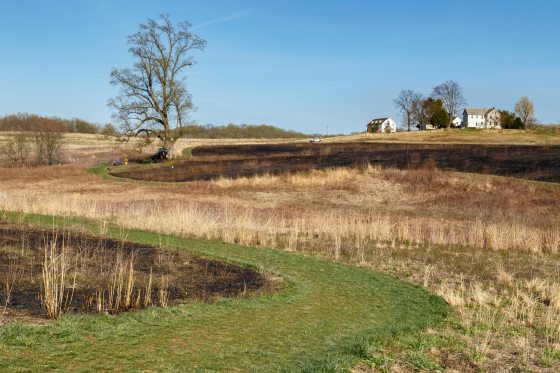
The temporarily black lunar landscape—which will soon be followed by new green shoots. Photo by Tom Potterfield.
Our key aim is to develop and manage the living landscape by using ecologically appropriate methods in a safe manner. As a result of the prescribed burn we now have a healthier living landscape. As the regenerated Meadow Garden springs back to life we invite you to visit Longwood Gardens to witness the wonders of this natural, but carefully managed, meadow landscape.

